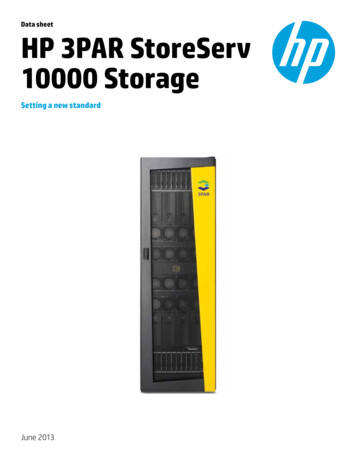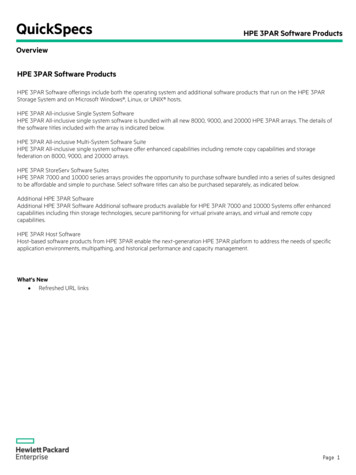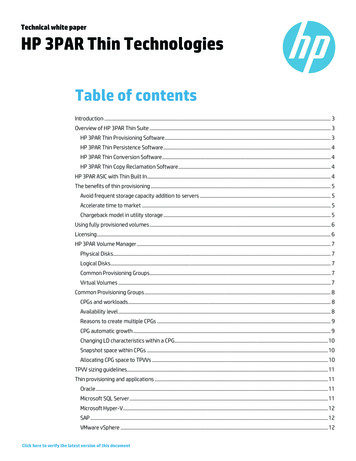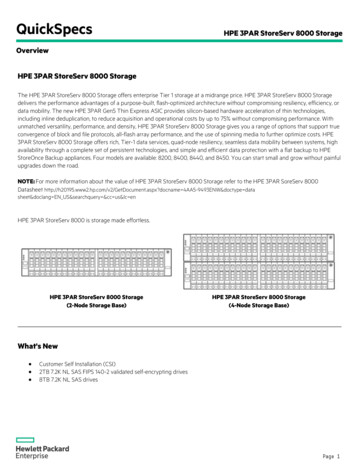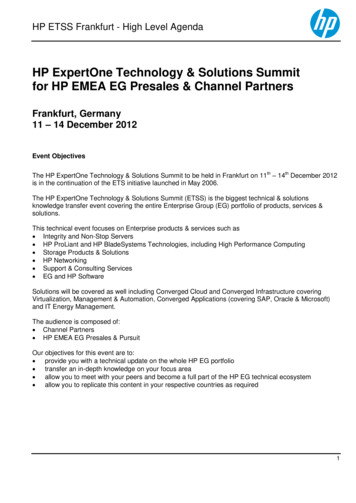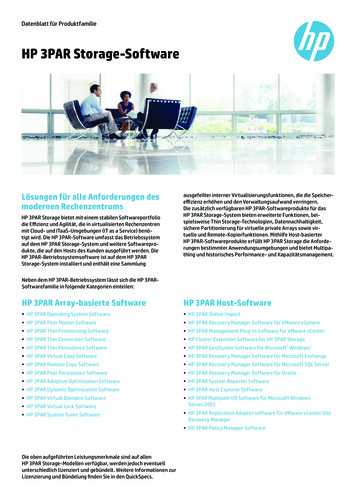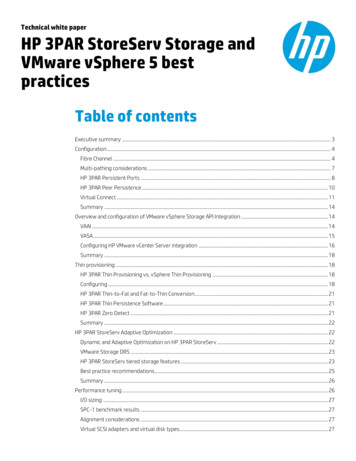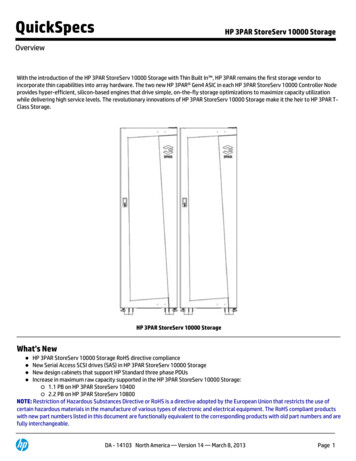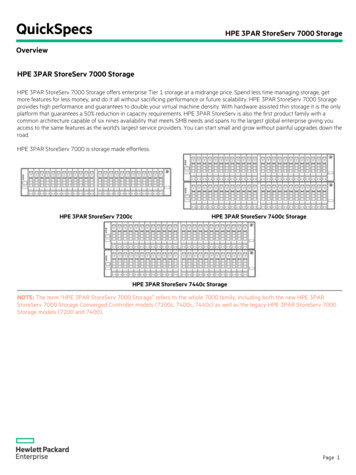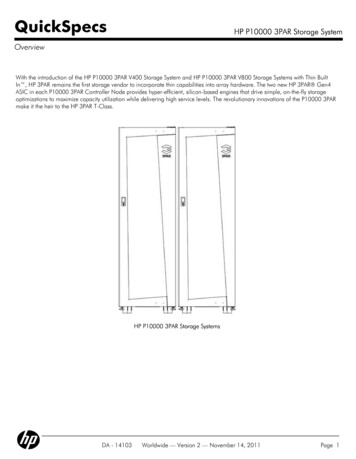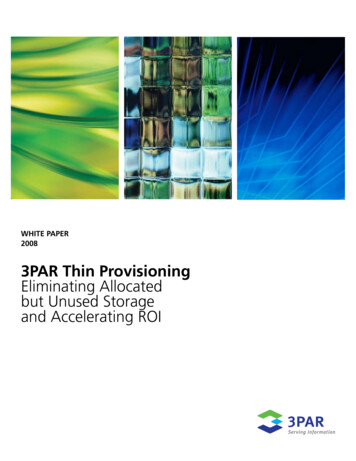
Transcription
WHITE PAPER20083PAR Thin ProvisioningEliminating Allocatedbut Unused Storageand Accelerating ROI
3PAR Thin Provisioning Eliminating Allocated but Unused Storage and Accelerating ROITable of ContentsIntroduction 3Problem: Unused Allocated Capacity 3An Understood Problem? 3Sizing the Problem 4Behind the Problem: Root Causes 5Solution: 3PAR Thin Provisioning 6Summary Business Benefits 9Reduced Capital Expenditures 9Lower Operating Expenses 9Accelerated Return on Investment 93PAR Thin Provisioning Architecture 103PAR Traditional Virtual Volume Management 103PAR Thin Provisioning Volume Management 11Thin Provisioned Virtual Volumes (TPVVs) 12Common Provisioning Groups (CPGs) 12How 3PAR Thin Provisioning Works 133PAR Thin Provisioning Alerts 15Summary 16About 3PAR 172
3PAR Thin Provisioning Eliminating Allocated but Unused Storage and Accelerating ROIIntroductionBalancing new project demands and limited IT resources is the challenging, often thankless, jobof IT management. IT managers must constantly evaluate the efficiency of tools and processesused to serve and manage corporate data. Of the many proposals to improve efficiency, few areactually implemented. Of those, fewer still achieve demonstrable success. 3PAR Thin Provisioningis a simple proposition that succeeds by saving organizations millions of dollars while letting newprojects be initiated on demand.This white paper discusses the problem of allocated, but unused, storage —the storage that hasalready been assigned to applications and file systems, but has not actually be written to. It alsoconsiders the high tax organizations pay to provision storage in typical environments. 3PAR ThinProvisioning is then explained and proposed as an alternative to both of these issues. The resultis a dramatic reduction in capital and operating expense, and much greater cost control relativeto project outcome. Return on application investment is also accelerated because IT can quicklydeploy new applications without the delays associated with traditional provisioning. In addition tothe business benefits of this alternative, attention is given to how 3PAR Thin Provisioning workswithin the context of the 3PAR InForm Operating System.Problem: Unused Allocated CapacityAn Understood Problem?Discussions about poor capacity utilization usually focus on the inherent limitations of directattached storage. Storage that is attached directly to a given host is not accessible by other hostservers. This creates pockets of inaccessible and therefore unutilized capacity across organizations.Networked storage remedies this by creating shared access to storage assets, thus increasing capacityutilization. But, what about the capacity that has already been allocated to host applications?U N U S E D A L L O C AT E D C A PA C I T Y500500450unallocated to filesystemunused filesystemused shP-uXAIXsolarisWindowsSource: Glasshouse Technologies. From Storage Magazine article ”Integration” by Stephen Foskett, April 2003Fig. 013
3PAR Thin Provisioning Eliminating Allocated but Unused Storage and Accelerating ROIHow well is allocated storage used? That is, what percentage of the storage made available toapplications has actually been written to? For some organizations this is a troubling question.They know, or worse yet, only suspect there is a problem. For others, the question has not yetbeen considered.Recognized or not, the problem for most companies is alarming. Enterprises report, on average,that only 25%1 of allocated capacity is actually used by applications. Needless to say, thisis a extraordinary waste of capital resources. Consider a 1M investment in storage capacity.Expected returns are generated on 250,000 of this investment. But the remaining 750,000 islost. Rapid technology cycles and negligible residual values mean little hope of reclaiming thisvalue. This represents a tremendous disparity between incurred application cost and realized value.Unfortunately, this problem cannot be addressed simply by networking storage.Sizing the ProblemFor companies, the magnitude of this problem stretches beyond poor returns on corporateassets. Operating expenses are wasted on the futile housing, powering, and cooling of countlessdisk drives that are effectively unused. Human resources, whether internal or contracted viaservice agreements, are consumed in the maintenance of these exaggerated infrastructures.Finally, storage related software license fees, which are commonly based on raw capacities,G L O B A L C O S T O F W A S T E D C A PA C I T YC O S T TO E N DUSERSRESOURCECONSUMPTION3 2,700 Megawatts in power and cooling*3 At a cost of 2 billion/year3 Equivalent to energy production of 9 averageUS power plants (coal)3 Requires 12 million tons of coal to produce, or3 Requires 40 million barrels of oil—2 days of total US oil consumptionC O S T TOENVIRONMENT3 Creates 34 billion lbs. of carbon dioxide peryear, based on average sources of USelectricity (coal, oil, nuclear, hydro, etc.)*** –65 watts/drive ** –US EPA All other estimates based on US DOE figures.Fig. 021 Storage Magazine, April 2003. In a survey of 750 host systems at over a dozen small and largeenterprises, Glasshouse Technologies found that only 25% of allocated capacity is used. “The averagesite assigned just 75% of their storage to hosts, left 36% of that unavailable to applications and onlyused 39% of what was usable. So a typical host might have 500GB of external storage, 375GB involume groups, 240GB in file systems, and just 93GB used,” noted Glasshouse Technologies.4
3PAR Thin Provisioning Eliminating Allocated but Unused Storage and Accelerating ROIexacerbate the problem. For example, a number of Storage Resource Management (SRM) softwaretitles are licensed this way, as are most software titles from storage array vendors such as EMC,Hitachi Data Systems, and Hewlett-Packard.For the global environment, there is also measurable cost. Consider the number of disk drives soldwithin multi-disk platforms, such as JBOD enclosures, arrays, and servers with multiple embeddeddisk drives. (Only these platforms offer, in practice, the alternative of using fewer disk drives.)Assuming drives are deployed no longer that 5 years, historical drive shipments and projectionsfrom the Gartner Group2 put this installed base at roughly 74 million disk drives. Using theGlasshouse Technology figures from above, this translates into roughly 42 million disk drives ofunused allocated capacity in multi-drive platforms. See the table below for the estimated effects ofthis “waste.”Behind the Problem: Root CausesThe “allocated but unused” problem occurs for a number of reasons, both organizational andtechnical. These include: Over-Requests for Capacity: When sponsoring departments or application administratorsrequest capacity they account for current needs, as well as anticipated growth. To theextent expected growth is uncertain, capacity estimates are increased. Wishing to assuregood quality of service for a new application, users may request enough capacity to avoidany downtime that could result from depleting or augmenting an insufficient amountof capacity. Applications that Are Less Successful than Planned: Sometimes applications are simply notutilized as originally anticipated, and so little growth actually occurs. Meanwhile significantstorage has already been provisioned and allocated. Replication of Unwritten Data: For many applications, additional copies of data volumesare kept on-line. These may serve to protect data and enable recoveries after corruptions ordisasters. Or these copies may enable more flexible data sharing (e.g., testing, development,and decision support). Since most data volume copy technologies deployed today do notdistinguish between written versus unwritten portions of the volume, they physicallyreplicate the base volume in its entirety. Thus any “waste” in a base volume is perpetuatedthroughout all of its copies.2 Sum of disk drives from 1999-2002 from Gartner 2001 Disk Storage Systems WW (Host AttachedInternal RAID, Host Attached External RAID, External RAID Controller-based, & NAS).5
3PAR Thin Provisioning Eliminating Allocated but Unused Storage and Accelerating ROIR E P L I C AT I O N O F U N W R I T T E N D ATA3 TB3 TB3 TB24TB3 TB 720,0003 TB3 TB(at 0.03 per MB)Fig. 03 Over-Provisioning to Avoid Future Allocation Complexity and Risk: Since storageprovisioning is complex and painful, follow-on allocations of capacity can be postponedor avoided by generous provisioning initially. Typically, provisioning is a manual processrequiring careful planning and coordination by IT management, storage administrators,system administrators, and application administrators. The process can be characterized bydelay and downtime since numerous people and steps are involved at different layers of theinfrastructure—storage allocation from an identified storage pool; planning, configuringand export of volumes from storage array to host; switch fabric configuration and zoning(if necessary), application LUN addition/extension, file system configuration, applicationconfiguration, and backup system configuration. Existing Technologies are “Dedicate-on-Allocation”: Traditional storage uses Dedicate-onAllocation technology. Customers have to purchase all the storage they want to allocateup front. The “capacity-on-demand” solutions offered by some vendors do not alleviatethis condition since, again, physical capacity must be installed and configured up front—only then is it available to be allocated by the customer at some time in the future. Theseprograms effectively pre-position drive inventory at customer sites while charging customersa price premium for this “service.” Such programs do not address the utilization efficiencyallocated capacity.In summary, a number of reasons cause allocated storage capacities to far exceed true demandfor written data. Such over-procurement of capacity is made worse in light of falling drive prices.Organizations that have allocated 300% more than their current need are not effectively leveragingthe 25% to 35% annual decrease in disk drive prices.Solution: 3PAR Thin Provisioning3PAR Thin Provisioning offers a simple solution to the problem of unused allocated capacity. ThinProvisioning allows IT departments to safely allocate to an application as much logical capacity asconceivably needed over its lifetime. Meanwhile, physical capacity is drawn from a common poolof purchased storage on an as-needed basis. That is, only when application writes occur is physicalcapacity drawn from the pool. 3PAR Thin Provisioning is “Dedicate-on-Write,” as opposed to“Dedicate –on-Allocation.” Physical capacity can be added to the buffer pool non-disruptively atany time.6
3PAR Thin Provisioning Eliminating Allocated but Unused Storage and Accelerating ROITHIN PROVISIONINGTraditional (Fat) Provisioning—Dedicate on Allocation—Volume3PAR Thin Provisioning—Dedicate on DataVolumeWrittenDataPurchased Physical FERPOOLPurchased Physical CapacityFig. 04By breaking the traditional link between allocated and purchased capacity, Thin Provisioning allowsapplication costs to grow in direct accordance with application use and growth. Users can continueto request, and receive, desired amounts of capacity. But purchasing is now determined by actualutilization, so costs are less dependent on the ultimate “success” of the application. For IT there isan important additional benefit: the pain and complexity of provisioning is dramatically reduced.By allocating “generous” amounts of logical capacity to applications upfront, follow-on provisioningtasks and workflow are eliminated. Administrators can “allocate once,” safely and economically.(Mechanisms for monitoring and controlling planned and unplanned growth of data will bediscussed later.)R E D U C E D W O R K L OA D : F O L L O W- O N P R OV I S I O N I N ng Provisioning1Find an application that’s running out of space or performance2Determine how to add storage (extend a LUN, make new LUN)3Determine how much storage to addDetermine where in pool to obtain additional storage from4(taking performance and availability issues into account)5Allocate storage from pool6Set protection (LUN masks) of storage server so app can see it7Set switch zoning if necessary so app can see storage server8Add new storage to app LUN or form new app LUN9Configure O/S file system to handle bigger/new LUN10Configure application to utilize bigger/new LUN11Configure Backup system to back up bigger/new LUN12Replenish pool, if necessary (buy disks, build new lifiedEffortNo EffortRequiredFig. 057
3PAR Thin Provisioning Eliminating Allocated but Unused Storage and Accelerating ROILeveraging 3PAR’s 3-layer virtualization capabilities, the 3PAR InServ Storage Server presentsto hosts storage volumes (LUNs) of any size and service level. Meanwhile, physical capacity isintelligently dedicated only as the application writes data.This intelligence is shared across the InServ platform. Therefore, all data copies throughout thesystem can also be “Thin Provisioning aware.” For example, 3PAR Full Copy, a software facilityfor making full physical copies, will only consume the same physical capacity as the underlyingThin Provisioned volume. With 3PAR Virtual Copy, a copy-on-write snapshot technology, evenmore space is saved for local copies. With Virtual Copy, only the changes to the base volume orD E D I C AT E - O N - W R I T DEDICATES600 GB600 GB200 GB200 GBFig. 06to the copy (subsequent to the creation of the Virtual Copy) consume physical capacity. Typicallythis is only a fraction of the capacity of the base volume. Lastly, with 3PAR Remote Copy, copiesmirrored to other InServ Storage Servers (typically at remote sites) are just as space-efficient as thebase thin provisioned volumes.Note that for both Full Copies and Remote Copies, full physical capacity can be optionally dedicated.This is commensurate with the allocated logical capacity of the base thin provisioned volume.R E P L I C AT I O N O F W R I T T E N D ATA O N LYTHIN PROVISIONEDBASE VOLUME3PAR VITUAL COPY. 3 TB3PAR REMOTE COPY. 3 TB 138,000(at 0.03 per MB)Fig. 078
3PAR Thin Provisioning Eliminating Allocated but Unused Storage and Accelerating ROIIn summary, this platform-wide efficiency represents tremendous savings and resolves the technicalissue of replicated unwritten data, a key cause of the “allocated-but-unused” problem. Organizationsmay wish to leverage this efficiency by using local and remote copies in connection with moreapplications. For example, disaster recovery may now be feasible for applications that could notbe economically protected before.Summary Business BenefitsReduced Capital Expenditures3PAR Thin Provisioning reduces capital expenditures by eliminating disk expenditures immediatelyand by postponing them indefinitely (forever in the case of many applications). For applicationswhere local or remote on-line copies are used, capital savings are a multiple of the number ofcopies. For financial and IT managers, this assures much greater control of capital expenditures andlinks them directly to the return from a given application. As physical capacity is purchased andadded over time, users also leverage falling disk drive prices more effectively. Finally, with 3PARThin Provisioning, customers can reduce license fees paid for many storage software products, likeSRM tools.Lower Operating Expenses3PAR Thin Provisioning dramatically lowers operating expenses by conserving electricity andfloor space, otherwise expended for powering, cooling, and housing unnecessary disk drives. By“allocating once,” the IT organization is relieved of repeatedly performing onerous and error-pronetasks related to follow-on storage planning and provisioning. This results in workload and workflowreduction for administrators across the IT organization. Note that even the initial provisioning ofapplication-tailored volumes with the 3PAR platform is a mere matter of seconds. Thus, storagecan be intelligently provisioned for an application, for its lifetime, in a few brief seconds. Lastly,application downtime traditionally required to perform follow-on allocations, reconfigurations,and rebooting is eliminated.Accelerated Return on Investment3PAR Thin Provisioning addresses a final business concern—return on IT investment. As discussedearlier, Thin Provisioning enables a greater number of projects for less cost. Within a given budget,Thin Provisioning allows more applications to be deployed, with each one costing significantly lessthan before. Just as importantly, applications can be deployed faster. No longer is IT required towait until next quarter’s or next year’s budget allocation in order to deploy additional applicationsthat will generate return for their corporation. Nor are they required to wait until needed storage isplanned, sized, negotiated, procured, and installed before storage can be allocated. By maintaininga small buffer of physical capacity, IT can quickly and easily deploy new applications as and whenthey are needed. In either case, delays are eliminated and ROI is accelerated.9
3PAR Thin Provisioning Eliminating Allocated but Unused Storage and Accelerating ROIENABLE NEW PROJECTS AND REDUCE PROJECT RISKTraditional (Fat) aWrittenDataWrittenDataWritten Written BUFFERDataDataPOOLPROJECTPROJECTAThis Quarter(start projects,purchase storage)B10 TBsABEXTRAPROJECTCOMMON5 TBsPROJECTANext Quarter(evaluate projects)3PAR Thin nDatabig cost, small returnPVROENBIFALEDWritten WrittenDataDataEXTRAPROJECTENOVPRWrittenDatasmall cost, big/accelerated returnFig. 08Capacity is always available to start new projects, and administrator productivity has no dependencyon storage purchase, planning, or installation. In the end, many more projects with ROI potentialare initiated, and IT’s contribution to the overall business is increased.3PAR Thin Provisioning ArchitectureTo understand how 3PAR Thin Provisioning works, it is useful to first understand 3PAR’s approachto virtualization.3PAR Traditional Virtual Volume ManagementThe 3PAR InForm Operating System employs a 3-level mapping methodology similar to thevirtual memory architectures of server operating systems. The first level of mapping virtualizesphysical disk drives of any size into a pool of uniform-sized “chunklets” (256 megabytes (MB)each) and manages the redundant pathing to each chunklet and disk drive. The fine-grained natureof these chunklets eliminates underutilization of storage assets. Volumes can be sized preciselyand not according to large arbitrary increments. The chunklets’ fine-grained nature also enhancesperformance for all applications, regardless of their capacity requirements, by allowing distributionof chunklets across scores, or even hundreds of disks. Complete system access to every chunkletmeans no pockets of inaccessible storage.The second level of mapping associates chunklets with Logical Disks (LDs). This association allowslogical devices to be created with template properties based upon RAID characteristics and thelocation of chunklets across the system. LDs can be tailored to meet a variety of cost, capacity,performance, and availability characteristics, depending upon the service levels required. In addition,the first and second level mappings taken together serve to parallelize work massively across disks10
3PAR Thin Provisioning Eliminating Allocated but Unused Storage and Accelerating ROIVIRTUAL VOLUME MANAGEMENThost serverssee luns with tailoredperformance, availability,and capacityoltPvIrtuAl volumesof any size (1gb to 2tb each)logIcAl dIsKsintelligent combinations ofchunklets for tailored cost,performance, availabilitylogical disksarepre-dedicatedto support theentire logicalcapacityof virtualvolumesdWPhysIcAl dIsKsbroken into chunklets(256mb each)Fig. 09and their Fibre Channel connections. The third level of mapping associates traditional VirtualVolumes (VVs) with multiple LDs. VVs are virtual capacity representations that are ultimatelyexported to hosts and applications.With traditional Virtual Volume management, all of these mappings are set at VV creation. Thoughchanges may be made subsequent to creation (for example, to optimize the chunklet location),a full mapping exists at all times for all logical capacity of a base VV. Underlying chunklets andLDs (or portion of LDs) are thus “pre-dedicated” to a given VV, regardless of how much has beenwritten to that VV.(Please note that users are not required to manage these layers or associations. The InFormOperating System handles this automatically. Application-tailored Virtual Volumes are typicallycreated and exported to hosts in a just a few seconds.)3PAR Thin Provisioning Volume Management3PAR Thin Provisioning Volume Management removes the pre-dedication of physical capacity. Itbuilds on the 3PAR traditional volume management, but adds an intermediate function, knownas a Common Provisioning Group. The CPG function sits between the VV layer and the LD layer.Unlike traditional 3PAR virtual volume management where VVs are “backed” 100% by LDs, a CPGeffectively creates LDs from free chunklets on an as-needed basis. A CPG then maintains mappingsfrom its “owned” LDs to VVs that have been associated with it. A base VV that depends on a11
3PAR Thin Provisioning Eliminating Allocated but Unused Storage and Accelerating ROITHIN PROVISIONED VIRTUAL VOLUME MANAGEMENThost serverssee luns with tailoredperformance, availability,and capacityoltPvIrtuAl volumesof any size (1gb to 2tb each)common ProvIsIonIng grouPsmanage the creation anddedication of logical diskslogIcAl dIsKsintelligent combinations ofchunklets for tailored cost,performance, availabilitylogical disksare createdanddedicated asneeded tosupport the“written to”portion ofvirtualvolumesdWPhysIcAl dIsKsbroken into chunklets (256mb each)Fig. 10CPG is known as a Thin Provisioned Virtual Volume (TPVV). Note that just as with traditionalVV management, there is still massive parallelism of work over system resources, with chunkletsdistributed across scores, or even hundreds of disks.Thin Provisioned Virtual Volumes (TPVVs)Virtual capacity is represented to host servers and applications using TPVVs. Upon TPVV creation,a fraction of its exported virtual capacity is mapped to LD regions in the CPG. When applicationwrites are made to the TPVV, the InForm OS allocates space from pre-mapped LD regions in finegrained increments to accommodate the write. Over time, as available space in the LD regionsmapped to the TPVV runs low, additional capacity is automatically allocated by mapping newregions from LDs in the CPG.TPVVs behave like traditional VVs—the differences are transparent to the host. TPVVs can serveas base volumes for Virtual Copies, Full Copies, or Remote Copies. As with traditional VVs,application-tailored TPVVs are created and exported to hosts in a just a few seconds.Common Provisioning Groups (CPGs)As discussed, CPGs provide a buffer pool of LDs with an associated mechanism to automaticallydedicate LD capacity to mapped TPVVs as needed. Key attributes of CPGs include:12
3PAR Thin Provisioning Eliminating Allocated but Unused Storage and Accelerating ROI Fine-Grained Capacity Pooling: CPGs enable fine-grained, shared access to pooled logicalcapacity. Instead of pre-dedicating LDs, however small or large, to traditional VVs, a CPGallows multiple TPVVs to share a buffer pool of LDs. When a TPVV requires more dedicatedcapacity, a CPG automatically assigns logical capacity to the TPVV by mapping new regionsfrom its LD pool. So, while a CPG pool contains dedicated LDs, pooled resources remainundedicated to TPVVs until needed. Auto Growth: By default, a CPG is configured to create new LDs when the amount ofavailable LD space falls below a configured threshold. The initial buffer pool of LDs startsoff at a fraction of the exported virtual capacity of mapped TPVVs and auto-grows overtime as required by application writes. Effectively logical capacity growth tracks the growthin actual used capacity, allowing customers to purchase and install physical capacity asneeded over time. LDs can also be manually assigned to a CPG.Moreover, template LD properties (such as RAID characteristics and the chunklet location)are specified per CPG and are applied uniformly across the LDs in a CPG. To take maximumadvantage of Thin Provisioning, users may wish to group applications by service levels, whichcan then be associated with various CPGs. This not only enables users to meet their applicationrequirements, but also allows more volumes to share a CPG, and thus share a common amountof like buffer capacity.How 3PAR Thin Provisioning Works(1) CPG Creation: To take advantage of Thin Provisioning a user first creates a CPG. TemplateLD properties such as RAID characteristics and the location of chunklets across the systemare specified based on application requirements. In addition, the growth increment for LDsis specified in gigabytes (GB). The growth increment defines the size for initial LD creationas well as for subsequent growth of LDs as available capacity is used by the application.Alternatively, the user can manually admit LDs into the CPG and “opt out” of automatedlogical capacity growth by configuring the growth increment to zero. This may be desirablefor users who wish to pre-allocate a fixed amount of capacity for TPVVs and utilize theremainder for traditional VVs. Lastly, allocation warning and allocation limit for the CPGare specified based on application requirements and internal storage allocation policy.1 ) C P G C R E AT I O NLDCommon Provisioning GroupFig. 1113
3PAR Thin Provisioning Eliminating Allocated but Unused Storage and Accelerating ROI(2) TPVV Creation: To export virtual capacity to the host, the user creates a TPVV and exportsit as a VLUN to the host. During creation, the TPVV is associated with a CPG, which prededicates minimal logical capacity to it—a fraction of its exported virtual capacity.2 ) T P V V C R E AT I O NOLTPTPVVs-- -- ------LDCommon Provisioning GroupFig. 12(3) Capacity Allocation: As applications write to TPVVs, space is mapped in fine-grainedincrements from previously mapped LD regions to accommodate the writes. As the TPVVspace runs low, the CPG prepares for more writes by mapping new regions from LDs in theCPG to the TPVV.3 ) C A PA C I T Y A L L O C AT I O NOLTPNew writesTPVVsLDCommon Provisioning GroupFig. 1314
3PAR Thin Provisioning Eliminating Allocated but Unused Storage and Accelerating ROI(4) Auto-Growth: Once the available logical capacity in the CPG falls below a pre-configuredthreshold, the CPG automatically adds LDs in accordance with the specified capacity growthincrement. A CPG continues to auto-grow LDs, as needed, until either its Allocation Limitis reached or until sufficient physical capacity is not available to satisfy the requirements ofspecified LD characteristics.4) AUTO-GROWTHOLTPNew writesTPVVs----------LDLDCommon Provisioning GroupFig. 143PAR Thin Provisioning Alerts3PAR Thin Provisioning provides multiple categories of alerts that notify storage administratorsof important events: Allocation Warnings – Allocation Warnings provide a mechanism for warning storageadministrators when a specified logical capacity threshold is reached. An allocation warningcan be specified independently for TPVVs and CPGs. Allocation Limits – Allocation Limits provide a mechanism to prevent “run away”applications—applications that are in an abnormal state and continuously write data tothe storage device—from consuming logical capacity beyond the specified logical capacitythreshold. Allocation limits can be specified independently for TPVVs and CPGs. For aTPVV, once the allocation limit is reached, the logical capacity allocated to the TPVV stopsgrowing and new application writes fail. Similarly, for a CPG, once the allocation limit isreached, the automatic creation of new LDs, if configured, is disabled. New applicationswrites to TPVVs mapped to the CPG receive a write failure until the limit is raised. Used Physical Capacity – As available physical capacity across the 3PAR InServ Storage Serveris utilized by traditional VVs and/or TPVVs, multiple pre-configured alerts are generated thatprovide information about used physical capacity as a percent of total system capacity. ForCPGs configured with default LD characteristics, these alerts serve as an advance warningto the storage administrator to plan for and add necessary physical capacity. In the unlikelyscenario that effective physical capacity becomes used, the 3PAR InServ Storage Servernaturally prevents new writes from occurring until more capacity is added.15
3PAR Thin Provisioning Eliminating Allocated but Unused Storage and Accelerating ROIThese alerts combined with various alert delivery mechanisms (3PAR InForm CLI, 3PAR InFormGUI, SNMPv2 Traps, and email/page from 3PAR Central) enable storage administrators to manage3PAR Thin Provisioning in the way that suites them.Summary3PAR Thin Provisioning represents a new, cost-effective way to purchase and manage storage.Thin Provisioning solves the allocated-but-unused problem, saving millions of dollars in base andreplicated capacity, as well as related costs for housing, powering, cooling and software licenses.It provides a simple and powerful means of linking project cost directly with project outcomewhile requiring no behavioral changes from storage requestors. At the same, it directly addressesthe distorting effects of provisioning comple
solutIon: 3PAr thIn ProvIsIonIng 3PAR Thin Provisioning offers a simple solution to the problem of unused allocated capacity. Thin Provisioning allows IT departments to safely allocate to an application as much logical capacity as conceivably needed over its lifetime. Meanwhile, physical capacity is drawn from a common pool
